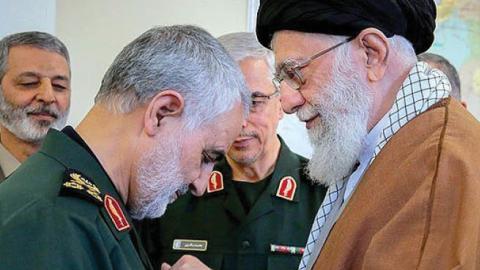“Seismic!” “Game Changing” “A Perilous Turning Point…” So said the quick takes from international news sites as the shocking story spread:
On January 3, 2020 the United States brazenly assassinated Iran’s notorious general, Qasem Soleimani.
Was it really such a big story? After all, Sunni radicals Osama bin Laden and Abu Bakr al-Baghdadi were also tracked down by the U.S. military and met their demise. Bin Laden was shot dead by elite American warriors. And al-Baghdadi, cornered and terrified by a similar team of U.S. Special Forces, detonated his suicide vest and blew himself to pieces, along with several small children.
So why the big deal about the Shiite General Qasem Soleimani?
His name was not that familiar to westerners. However, in actual fact, the general wasn’t just some notorious terrorist—although he certainly was that. Gen. Soleimani was also the commanding officer of Iran’s lethal Islamic Revolutionary Guards Corps Quds Force. And he was coordinator of several Iranian proxy militias who continue to impose widespread mayhem across the Middle East.
Most significantly, in the eyes of many, Gen. Qasem Soleimani was the second most powerful man in Iran.
NBC-News put it like this:
For the majority of his more than 20-year career at the top of Iran’s Quds Force — the foreign operations wing of the elite paramilitary Islamic Revolutionary Guard Corps — the commander, who died at age 62, operated largely in the shadows. But in recent years he’s become something of a celebrity and the face of Iran’s expanded influence across the Middle East.He was known as the mastermind behind the Islamic Republic’s vast network of proxies stretching from Iraq and Lebanon to Syria and Yemen.
And the unique power Soleimani held to shape Iran’s foreign policy and carry out covert offensive acts — what the Trump administration dubs “malign activity” against U.S. regional interests and allies — made him unparalleled as a military and intelligence operative in the region….”
Soleimani’s level of importance in Iran and across the Shiite Muslim world was reflected in his final orders to his troops.
On Dec. 27, under Soleimani’s command, Iranian-proxy Shiite militia Kataeb Hezbollah launched an attack on a U.S. military base near Kirkuk, Iraq. Their barrage of 30 rockets struck and killed an American contractor, while injuring several U.S. service members and Iraqi troops.
In response, according to Stars and Stripes, the American military blasted five targets: “These locations included weapon storage facilities and command and control locations that Shiite militia Kataeb Hezbollah uses to plan and execute attacks on Operation Inherent Resolve coalition forces.” Following the U.S. attack, Iranian news reported that Kataeb Hezbollah’s death toll was around a dozen militiamen.
And that wasn’t the end of it. Next, the American embassy in Baghdad was assaulted by enraged, vandalizing “protestors.” Although the heavily fortified embassy building was more or less only superficially damaged, its security was clearly violated. And, as Tony Badran reports, “Graffiti on the embassy walls declared Soleimani to be the attackers’ commander….”
Fortunately, heavily armed U.S. troops soon appeared in Baghdad and the intruders melted away.
As Badran observes, “Apparently, Khamenei, who according to Iranian regime doctrine exercises the authority of the missing 12th Shiite imam on earth, didn’t imagine what was coming next.”
According to Sec. of State Mike Pompeo, U.S. military intelligence had solid evidence that additional attacks on American troops were eminent. So the U.S. chose to take preemptive action against Gen. Qasem Soleimani and Abu Mahdi al-Muhandis, his top lieutenant.
In the bloody and dismembered aftermath, the world was stunned into momentary silence. Then, unsurprisingly, a tsunami of threats and accusations against the U.S. began to flood the airwaves and social media.
Lebanon’s Hezbollah is, of course, Iran’s best-known proxy warfare machine, and its primary mission is frequently chanted: “Death to Israel.”
Today, thanks to the late General Soleimani, countless civilian neighborhoods across southern Lebanon are armed with far more than 100,000 Hezbollah missiles, aimed directly across Israel’s border and capable of reaching deeply into the heart of the Jewish State.
Meanwhile Hezbollah’s Lebanese Chieftain, Hassan Nasrallah, shares Iran’s bizarre end-of-days vision for the death and destruction of Israel’s Jews. He anticipates his troops conquering the Jewish Temple Mount in order to “save” al-Aqsa Mosque. Sheikh Nasrallah broke down in tears on camera while attempting to announce Soleimani’s demise. After he calmed down, he declared:
“Meting out the appropriate punishment to these criminal assassins will be the responsibility and task of all resistance fighters worldwide. To continue on General Soleimani’s path, we will carry his flag on all battlefields and all fronts, and we will step up the victories of the axis of resistance with the blessing of his pure blood.”
As for Iran’s “Supreme Leader,” Ayatollah Seyyed Ali Khamenei minced no words.
“The cruelest people on earth” assassinated the honorable commander who “courageously fought for years against the evils and bandits of the world. His demise will not stop his mission. But the criminals who have the blood of General Soleimani and other martyrs of the Thursday night attack on their hands must await a harsh revenge… Martyr Soleimani is an international figure of the Resistance, and all the devotees of Resistance are now his avengers.”
If those two declarations sound faintly religious and even mystical, that’s because they are.
Far removed from western secularism, most of Iran’s leadership and their henchmen belong to an apocalyptic religious cult, and eagerly await the imminent arrival of their messianic figure, the Twelfth Shiite Imam. The “End of Days” is believed to follow.
And, in fact, Soleimani was a deep devotee of the 12th Imam cult. With that in mind, consider this pronouncement from senior Iranian Ayatollah Mohammad Mehdi Mirbagheri: “In order for the Hidden Imam to reappear we must engage in widespread fighting with the West.”
Saeed Ghasseminejad, who was born and raised in Iran, is an expert analyst at Washington D.C.’s Foundation for Defense of Democracies in Washington D.C. In non-apocalyptic terms, he offers insights into Gen. Soleimani’s great success, and foresees his successor’s challenges. What will the present upheaval in Iran—following Soleimani’s demise—bode for the future? Ghasseminejad explains:
“It will be difficult to replace Soleimani because he built the Quds Force's network of terrorists around himself. He had a deep personal relationship with the leaders of Shia militias and terrorist groups in the region. His successor, Esmail Qa'ani, does not enjoy the same charisma and personal touch.
“Additionally, Soleimani spent years creating his image as the invincible smart head of Tehran's version of America’s Joint Special Operations Command (JSOC). The success of the image was significantly dependent on Soleimani's success in defeating the United States in Iraq.
“That image is not a mask that the next leader can put on.”
Soleimani's elimination also indicates that maybe Washington has finally realized that its strategic patience toward Shia terrorism is misguided and dangerous. Tehran immensely benefited from Washington's refusal to treat Shia terrorists the same way it has been treating their Sunni counterparts since 2001.
Ghasseminejad concludes, “Losing that shield will start a new era.”



















